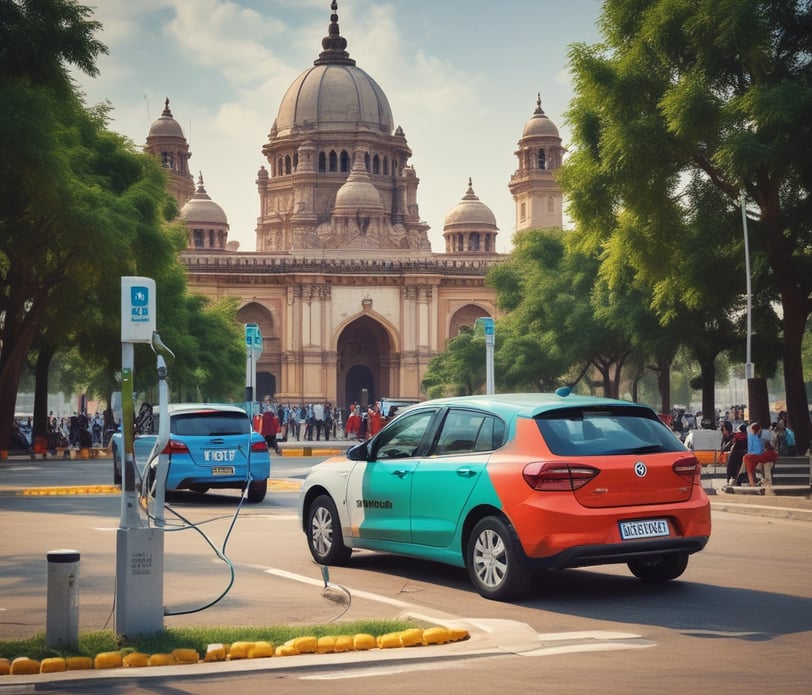"India's EV Revolution: How Karnataka, Maharashtra, and Uttar Pradesh Are Driving the Charge!"
Discover how Karnataka, Maharashtra, and Uttar Pradesh are spearheading India’s electric vehicle revolution by leading the way in public charging station installations. Learn what’s fueling their success and what it means for India's sustainable future.
BLOG POST
12/22/20244 min read


India’s EV Revolution: Karnataka, Maharashtra, and Uttar Pradesh Lead the Way in Public Charging Station Installations.
India’s journey toward a greener, more sustainable future is picking up speed, and the heroes of this story are states like Karnataka, Maharashtra, and Uttar Pradesh. These states aren’t just embracing electric vehicles (EVs) — they’re laying down the foundation for an EV revolution by championing public charging infrastructure. Here’s a deep dive into how these states are leading the charge and what this means for India’s broader EV ecosystem.
The Spark Behind the Growth of EV Infrastructure
The global shift toward clean energy has pushed India to set ambitious goals for EV adoption. By 2030, the country aims for EVs to account for 30% of all road vehicles. Achieving this, however, hinges on one crucial factor: accessible and reliable public charging infrastructure.
Karnataka, Maharashtra, and Uttar Pradesh have emerged as trailblazers. But what sets them apart? Let’s unpack their strategies, one state at a time.
Karnataka - The Pioneer of EV Policy
Karnataka was the first Indian state to roll out a comprehensive EV policy back in 2017. Known for its tech-savvy capital, Bangalore, the state recognized early on that the future of mobility lay in electrification.
Key Milestones:
Installation of 800+ public charging stations across urban and semi-urban areas.
Collaboration with private companies like Ather Energy and Tata Power to expand infrastructure.
Incentives for EV manufacturers and charging station operators.
Why It Works: Karnataka’s approach is deeply rooted in public-private partnerships. By leveraging its reputation as a tech hub, the state has attracted significant investment from startups and established players alike. For instance, Bangalore’s AtherGrid network ensures that EV users can easily locate and access charging points within city limits.
Real-World Insight: Imagine driving an EV through Bangalore’s bustling streets. With charging stations conveniently located near tech parks, malls, and residential complexes, range anxiety becomes a thing of the past. This accessibility encourages more residents to switch to EVs.
Maharashtra - The Financial Capital Fuels Sustainability
Maharashtra’s EV journey is driven by its economic might and environmental consciousness. The state has prioritized building a robust charging network to support its ambitious goal of 10 lakh EVs on the road by 2025.
Key Milestones:
Deployment of over 1,000 public charging stations, with a focus on Mumbai, Pune, and Nagpur.
Subsidies for EV buyers and charging infrastructure developers under the state’s EV Policy 2021.
Partnerships with energy providers like Adani Electricity and Tata Power.
Why It Works: Maharashtra’s strategy involves a mix of urban planning and financial incentives. By mandating EV charging points in new residential and commercial buildings, the state ensures long-term infrastructure growth. Moreover, its focus on electrifying public transport — such as Mumbai’s BEST buses — further boosts the demand for charging stations.
Real-World Insight: Picture this: A commuter in Mumbai seamlessly switches from an electric BEST bus to their personal EV, charging it at a station near their office. This integrated approach not only cuts down emissions but also sets the stage for a cleaner, quieter urban experience.
Uttar Pradesh - Empowering Rural and Urban EV Adoption
As India’s most populous state, Uttar Pradesh faces unique challenges in its EV adoption journey. Yet, the state has turned these challenges into opportunities, becoming a leader in expanding EV infrastructure to underserved areas.
Key Milestones:
Establishment of 1,200+ public charging stations, with significant coverage in rural and semi-urban regions.
Targeted subsidies for EV buyers, focusing on two-wheelers and three-wheelers.
Support for EV manufacturing hubs in Noida and Greater Noida.
Why It Works: Uttar Pradesh’s strength lies in its focus on inclusivity. By addressing the needs of rural EV users, the state ensures that electrification benefits extend beyond urban centers. This approach also aligns with its broader economic goals of boosting job creation in the EV sector.
Real-World Insight: Visualize a farmer in rural Uttar Pradesh using an electric three-wheeler to transport goods. With affordable charging stations located along major highways, the transition to EVs becomes both practical and economical.
The Ripple Effect Across India
The leadership of Karnataka, Maharashtra, and Uttar Pradesh in public charging infrastructure has set a benchmark for other states to follow. Their efforts are driving:
Increased EV Adoption: A robust charging network reduces range anxiety, encouraging more people to switch to EVs.
Job Creation: From manufacturing EVs to maintaining charging stations, the sector is generating employment opportunities across the value chain.
Environmental Impact: With more EVs on the road, India can significantly cut down on greenhouse gas emissions and air pollution.
What’s Next for India’s EV Revolution?
While Karnataka, Maharashtra, and Uttar Pradesh are leading the way, India’s EV story is far from over. Challenges such as high upfront costs of EVs, the need for standardization in charging infrastructure, and grid capacity constraints still need to be addressed.
However, with continued government support and private sector innovation, the country is well on its way to achieving its electrification goals.
FAQ Section
Q1: Why are Karnataka, Maharashtra, and Uttar Pradesh leading in EV charging infrastructure?
These states have implemented forward-thinking policies, invested in public-private partnerships, and focused on both urban and rural electrification.
Q2: How does public charging infrastructure impact EV adoption?
A reliable charging network reduces range anxiety and makes EVs a practical choice for everyday users, thereby boosting adoption rates.
Q3: What incentives are available for EV buyers in these states?
Each state offers subsidies, tax exemptions, and reduced registration fees to make EVs more affordable for consumers.
Q4: What challenges remain in expanding EV infrastructure?
Key challenges include high setup costs for charging stations, the need for uniform charging standards, and ensuring grid stability to handle increased electricity demand.
Q5: How can other states replicate the success of Karnataka, Maharashtra, and Uttar Pradesh?
By adopting similar policies, fostering public-private partnerships, and focusing on both urban and rural infrastructure development.
The EV revolution is here, and Karnataka, Maharashtra, and Uttar Pradesh are proving that with vision and effort, India can lead the world in sustainable mobility. The road ahead is electric, and these states are lighting the way forward
